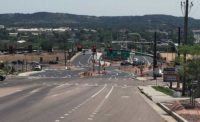California’s highways and roadways are currently getting a shot in the arm with infrastructure stimulus funds from the American Recovery and Reinvestment Act, but a number of high-profile road projects also broke ground last year despite a freefalling economy and with little or no extra federal money.


Among them are the Interstate 15 south and north segment projects and another phase of the U.S. 101 widening project in Napa, Sonoma and Mendocino counties.
Population growth in the Inland Empire and along San Diego County’s I-15 corridor has led to a major case of congestion, with commutes between State Routes 163 and 78, a 20-mi stretch, taking 30 to 45 minutes.
And with planners estimating that a daily peak of 290,000 vehicles will increase to 380,000 vehicles by 2020, increasing that drive to 90 minutes or more, Caltrans and the San Diego Association of Governments had no other choice but to expand.
That three-segment project, the I-15 Express Lanes, is well underway and the south segment, with a construction cost of $481 million, tops our list of the Top 25 Highway Projects for 2009.
I-15 is a major route from the Southwest into the Intermountain West, connecting San Diego and Los Angeles to Las Vegas, St. George, Provo, Salt Lake City, Pocatello, Idaho Falls, Butte and Great Falls. It runs 1,433 mi.
Since I-15’s completion in the 1970s, California, Nevada and Utah have consistently ranked in the fastest-growing areas of the U.S. and the I-15 corridor has grown in popularity with the population increases. It is now one of the most crowded freeways in the state.
To relieve the congestion in the San Diego segment, Caltrans is expanding I-15 with a four-lane, 20-mi express lane in the median.
Stretching from SR 163 north to SR 78, the new lanes are the first adaptable, high-tech transportation project configured to adapt to the needs of local travelers, commuters and commerce. The lanes will serve vanpools, carpools, buses, and FasTrak customers. Tolls for FasTrak users will vary from 50 cents to $8 depending on the distance traveled, the time of day and the level of traffic congestion on the Express Lanes.
The I-15 Express Lanes will feature a moveable barrier for maximum flexibility (similar to the moveable barriers on the San Diego-Coronado Bridge); multiple access points to the general purpose highway lanes; and direct access ramps for high-frequency Bus Rapid Transit service.
The middle segment has opened in two phases. The first phase from SR 56 to Rancho Bernardo Road opened in September. The second phase from Rancho Bernardo Road to Centre City Parkway opened in March. The north segment and the south segment are scheduled to open to traffic in 2011 and 2012, respectively. Each segment is made up of multiple construction units.
Several bridges along this stretch are being modified to accommodate the managed lanes. The Pomerado Bridge, which reopened for public use in January 2007, was demolished and completely rebuilt in nine months. The new and improved bridge features four lanes,...

